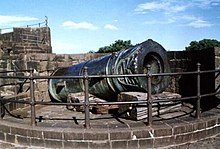Malik-E-Maidan
| Malik-E-Maidan | |
 A view of the Malik-E-Maidan Cannon, placed at Bijapur Fort. | |
| Location | Bijapur, India |
|---|---|
| Designer | Muhammad Bin Husain Rumi |
| Type | Cannon |
| Material | Bell metal |
| Length | 4.2 metres (14 ft) |
| Completion date | 1549 |

The Malik-E-Maidan also Malik-i-Maidan (Master of the Field) or (Master of the Battlefield), is a large early 16th century cannon, located at Burj-E-Sherz (Lion tower), Bijapur Fort, Bijapur, India.
History[]
The cannon was cast in 1549 by Muhammad Bin Husain Rumi—a Turkish engineer serving to Sultan Burhan Nizam Shah I of Ahmednagar, the Sultan presented the Cannon to his Son-in-Law Ali Shah.[1][2][3] In 1565 AD the cannon was used in the Battle of Talikota by Bijapur Sultan Ali Adil Shah I-an ally of Deccan Sultanates who joined forces to strike a decisive blow against the Aliya Rama Raya of Vijayanagara Empire. After the victory of Deccan Sultanates the cannon was named "The Malik-i-Maidan".[2][3] The cannon, among world largest in its category, was attempted to be shifted to Great Britain by East India Company as a war trophy, but due to its huge size and un-conditioned transport infrastructure the cannon could not be transported.[4] In 1624 AD Malik Amber, transported the Malik–i-Maidan with the help of trained war elephants from Daulatabad to Sholapur and used it in the Battle of Bhatvadi against Mughals and Bijapur Sultanat.[5]
Structure[]
The Malik-e-Maidan made of bell metal, measuring 4.2 metres (14 ft) in length, 1.5 metres (4 ft 11 in) in diameter, and weighing 55 tons, is the largest cannon in India.[citation needed]
Inscriptions[]
Three inscriptions can be found on the cannon, of which two were inscribed during Burhan Nizam Shah I of Ahmednagar as per the inscriptions. It was cast at Ahmadnagar from bell metal by Muhammad Bin Husain Rumi in 1549. The third inscription was added by Aurangzeb when he conquered Bijapur in 1685–86.[2]
See also[]
References[]
- ^ "Vijayapura Place of interest". Government of Karnataka. 17 February 2021. Retrieved 24 February 2021.
- ^ Jump up to: a b c "View of the Malik-i-Maidan Gun in the Fort at Bijapur". British Library. 26 March 2009. Retrieved 24 February 2021.
- ^ Jump up to: a b Wagoner, Philip B; Eaton, Richard M (2014). "Warfare on the deccan plateau, 1450-1600 : A Military Revolution in early modern India?". Journal of World History. 25 (1): 5–50. doi:10.1353/jwh.2014.0004. S2CID 162260578.
- ^ The Fortnightly. 34. Chapman & Hall. 1880. p. 226. Retrieved 24 February 2021.
- ^ Sadiq Ali, Shanti (1996). The African Dispersal in the Deccan: From Medieval to Modern Times. Orient Blackswan. pp. 81 and 86. ISBN 9788125004851. Retrieved 24 February 2021.
- Tourist attractions in Bijapur district
- Individual cannons
- Buildings and structures in Bijapur district